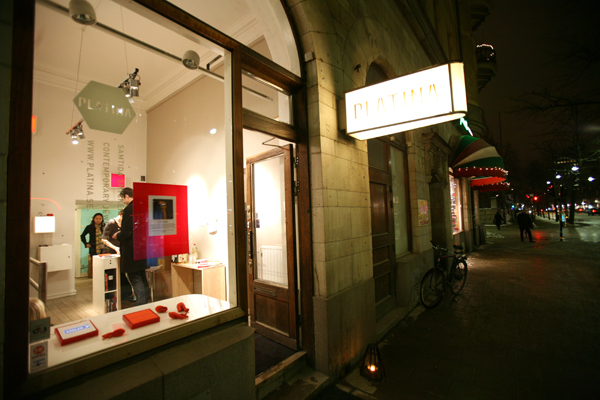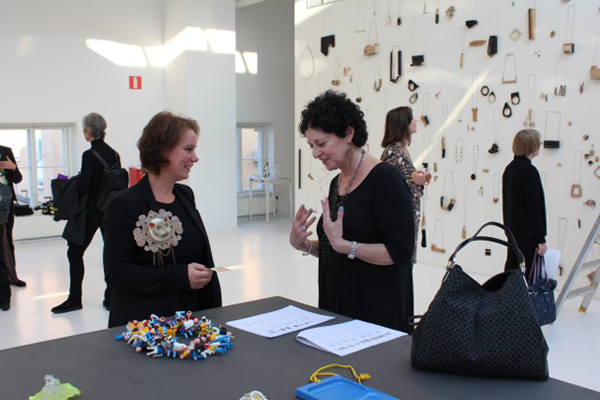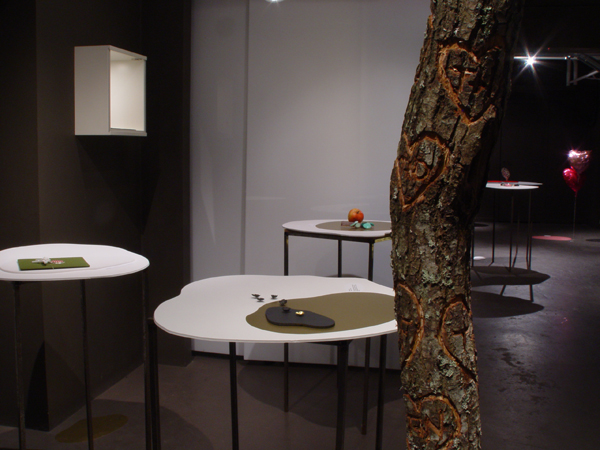
Kellie Riggs: I’ve recently listened to your lecture at the 2014 SNAG Conference in Minneapolis. One of my favorite things you said was something so simple: “Jewelry gives us satisfaction, it enables another way of being, seeing…” Can you talk more about this satisfaction? Does your gallery function as a means to share this satisfaction with others?
Sofia Björkman: Why are we doing what we do? Why jewelry? Keeping in mind that almost everyone owns a piece of jewelry, it must have a meaning, a function. Maybe it’s pretentious to begin an interview by asking these questions, but isn’t that the innermost driving force? A constant search for something else, isn’t that a basic human need? Does this give us satisfaction that we can share? Satisfaction is personal and I won’t even try to describe it. It’s said that we get happier by sharing, so I share with my audience what I find worth sharing.
You also stated that Platina started as a “platform” for contemporary jewelry; your initial thought was that a “gallery” would limit opportunities for working broadly. After a while, though, it sort of just became a gallery anyway. What has been the difference for you, between what Platina started as, and what it is today?
Sofia Björkman: I had just graduated when I started Platina, and I had so many ideas about what to do. I guess I had a naive picture of what a gallery does, without really knowing. Anyhow, that picture doesn’t match my ideas of a gallery today. At that time, I was fed up with people telling me how things should be and it affected the way I behaved and worked. During art education I learned that we, as artists, shall, with the art we do, question orders and do our own thing, but when it comes to everything around the art pieces and how to work as an artist—such as presenting work, having exhibitions, selling, marketing, awards, writing, and more—I had the feeling that most of that followed specific orders.
With that in mind, what is my role as a gallery owner? Can I do something else, or shall I do what is expected? A lot has changed during the years, but I guess my questions regarding this are more or less the same now as 15 years ago.
And you’ve recently celebrated Platina’s 15-year anniversary. Can you speak a bit about your exhibition, Fifteen Years of Jewellery Art? Am I correct that it was a four-day show at a different venue?
Sofia Björkman: Does a show have to be long? The most attendees come when they are personally invited and a short show is easier when it comes to security. I could be there to meet the audience and I could leave most of the pieces out in the open. The exhibition took place at Färgfabriken, the art space in Stockholm. They have three spaces in the building for exhibitions and I love the second largest, which is on the top floor. It has amazing light and a quiet atmosphere. A real birthday gift!

So in that sense, it’s perfectly logical it was very short even though it culminated a much longer period of time.
Sofia Björkman: To make an anniversary show, I could have collected as much as possible from over the years, framed it or put it in a box/space, and given myself a birthday gift. Actually it was Iris Eichenberg’s suggestion to give myself a gift, and I followed her recommendation. So what then is a birthday gift? There is so much nice stuff to choose from. It ended up with 15 artists, one for each year. One of them, A5, is a group of three, so to be precise I chose 17 artists for the show.
To me, your programming seems much more involved and all-encompassing than some of the other galleries out there. Perhaps there’s a greater sensitivity that comes with being an artist yourself that you then transfer to the programming of your exhibitions.
Sofia Björkman: So, do I work in a different way because I am an artist myself? Many of the gallery owners are artists themselves. We do enjoy and value different things, work in different ways, as we do as artists. I just try to do it in my way, and, yes, I want to be more inclusive than excluding, not to judge too fast, but rather try to work for the field’s development. A common question is if I have time for my own work. So, what is work? For an artist, the gallery comes at the end of the process; for a buyer, it’s the start. In this area I find interesting vibrations that I, both as an artist and a gallerist, use as material. In a way, it’s my working space. I like the thought that everything I do is a piece of art. Can I do business in an artistic way?
This is what I was hoping to get at, that there is no hierarchy between your artwork and your business. It’s really reflective of the care I see in your exhibitions as well. Is there any particular exhibition that comes to mind that exemplifies this best?
Sofia Björkman: I’m glad you say that there is no hierarchy between the artwork and the business, but I would say that discussions on this subject are always intense. I wonder if it’s possible to even think of the two as opposites. We can’t ignore either of the two. We are human beings in a physical, social, and cultural environment, a market, and jewelry isn’t an exception to this rule.
To mention one exhibition, it should be a solo by Helena Lindholm, in 2011. The pieces were displayed on scales. I have never seen such a confused audience and I learned a lot from this. We wrote:
“It is an exhibition but there is no title. The words are few but increased content. There are dreams and there are stories. There is jewelry with or without gemstones. There are different materials and much time spent. There are values, what you decide. There are no fixed prices. You can in this exhibition place a bid based on your own values. The necklace can be yours but we will determine.”
Why is it important for you to create involved environments for the jewelry, and how do you typically approach filling space?
Sofia Björkman: I am truly interested in the jewelry field as a whole. I am interested in pieces (the background and how they are made) as well as how jewelry functions in environments and in society. I am interested in the dialogue rather than the monologue. As a maker, I am interested in the receiver, as a receiver I am interested in the maker and what happens between the two. It’s the same with environments. The environment is as important for the piece as the piece itself. We can create environments or use already-existing environments that fit our ideas. Pieces can be highlighted in inspiring environments, as well as being killed in unpleasant situations…
I don’t have a general idea how things should be shown or displayed, but I would like to point out that what is regarded as neutral spaces/environments is not always as neutral as we might think. I don’t believe there are neutral spaces, but I think all spaces have potential as rooms for art jewelry.
When you take an exhibition outside the confines of the gallery—like the Inspired by Nature? exhibition at the Edvard Anderson Conservatory in Stockholm’s Bergius Botanic Garden, for example—what kind of challenges are presented? Why are these “out-of-gallery” shows important?
Sofia Björkman: There are a lot of reasons to step out of the gallery; one is to reach new audiences, another is that I already told half of the story by using a certain environment, like at the botanical garden. It was kind of clear that the subject is about nature. If I were to discuss a topic like human rights, I might choose another space. I also think it’s an easier way to let people in, into the world of art jewelry, with respect to actually getting them into the gallery. In a way, I force the audience to experience their interests in a different medium than they are used to. If I want to reach people, I need to invite them in, but I also need to visit and be interested in them. Working with people in other professions gives me knowledge about things far beyond what I already know.
We say that we learn from failure, but I will state that we also learn from doing things without being in control. This was my experience with that exhibition. I got a lot of unexpected experiences, mostly positive. In the gallery I hear a lot of smart things, but also silly things—for example that the pieces I show are useless, because you can’t wear them in the shower. Doing an exhibition in this conservatory, yes, the pieces had to function even if they got watered.

How do image or references come into play in exhibitions? Are they part of the story-telling?
Sofia Björkman: I think everything we do and experience depends on what references we have. Is it possible today to do anything without images or text references? But I think we should be aware of how we use them. An image as a photo or an image as a documentation of a piece are two different things, and the interpretation of it differs. Isn’t this valid with texts as well? We can display pieces in a room without images or text. But how do we get visitors there without it? How do we document it? I distinguish between visitors and audience. The visitors are the ones who come and see an exhibition, and the audience is those who get to know about it, through the references, Internet, or catalogs, for example.
I’ve noticed that Platina’s exhibition history includes a few shows where specific curators have been listed, curators who are in fact contemporary jewelry artists, like Mia Maljojoki and Beatrice Lang; Ela Bauer; Karin Seufert; and Silke Fleischer. Can you speak about these artist-run exhibitions?
Sofia Björkman: I am open to all kinds of cooperation and mostly I get something interesting out of it. I learn by working with brilliant people like the ones mentioned. We share ideas and experiences and learn other languages than the ones we already know. I am curious to see what will come out and happen when people I trust do something instead of me, or in conjunction with me.
When no one is listed as curator, are you the curator? What do you call yourself?
Sofia Björkman: Yes, then I am the curator. It’s always difficult to know what to call people. As you said about the people above, they are curators, artists, and they are more than that as well. I call myself different things depending on the situation and if I can, I avoid it. If I were to mention everything I do, gosh, the list would be very long. Can anyone today honestly just have one title? Using a title, isn’t it more about telling what position you have than actually telling what you do?

Sofia Björkman: Well, you see, thinking about love makes you love. Love is about trust, which is a theme I often discuss with my customers. Some customers are very open and tell me about their love affairs and sexual experiences. And I listen. So how can I not be influenced to do something from all this material? Love is a difficult theme, and challenging. It’s about strong feelings and includes clichés, as well as hate. Those exhibitions are good examples of the dialogue I have with the audience and the artists.
This goes back to what you said about each exhibition also being an art piece. You see love, or what you get out of dialogue with your visitors, as material.
Sofia Björkman: You know, I once invited some of my customers to exhibit something. They loved it!
It seems you’re constantly questioning and challenging yourself. For example, About Eating Art is a collaboration between you and Yasar Aydin. The project’s description states, “through interdisciplinary practice and experimental meals in combination with artistic work, we discuss current issues such as gender, ethnicity, class, ethics and the environment.” Can you talk a bit about Yasar and this project? Is it still ongoing?
Sofia Björkman: Yasar Aydin worked for me as an assistant after he graduated as a jewelry artist from Konstfack. We talked a lot about the big questions in life. One day we both were low and needed something pleasurable, and so this project started.
A project is limited by time, but with this work I’m not full yet. When does a work start and when does it end? As long as I am in it, it’s not clear to me. For the moment, I am sitting here with 200 pages of documentation and I think we have just ended the starter. It’s too early to tell, but for sure it will be visible in some way!
The project description for About Eating Art stated that the strength of contemporary jewelry lies in its ability to “be shown and used in both private and public contexts, intimately and spiritually” through human movement, which I love. You described the jewelry artist as a performer who operates in many different situations. Is the gallery one of those situations? As a gallerist, what is your favorite situation? As an artist, is it different?
Sofia Björkman: Lisa Walker has said that everything is food for art, and I totally agree. Sometimes it’s just difficult to know what to do with everything around. It’s a challenge to take something you at first don’t think is material but use it as material anyway. Food and the culture around food is something everyone can relate to, and it can be really weird when breaking norms and turning things upside down. This is a great source for work, both as a gallerist and as an artist. I learn a lot about human behavior but also about environments and spaces. What is the ultimate space for jewelry? I have tried to swap roles and call what I do as art not art and the opposite, just to see if I am right or wrong, honest to myself, or just to see if it is possible to call everything art—or jewelry… Everything gets blurry and I love the blurriness that triggers me to go on. Maybe these situations are the ones that thrill me most.

Sofia Björkman: I Care A Lot was a traveling exhibition organized by Dana Hakim and Yosef Bercovich from Israel. They called it A Portable Discussion, about current issues in the Middle East. In 1996–1997 I studied in Bezalel Academy in Jerusalem, and I had already met some of the participants in the exhibition there.
In 2010–2011 I organized a series of discussions. At that time, I was longing to hear what artists, writers, curators, and others had to say about how we use art jewelry in society and what is beyond words and expressions used in a routine manner, such as beauty, quality, strength, natural, authenticity, the conceptual, and more. During the exhibition of I Care A Lot, we discussed jewelry in a political context. I have written down what was said (about 100 pages) and it could be an interesting book. I am happy you’re asking about this exhibition and I think there is a lot more to say about it than what has been said so far.
To me, these kinds of projects indicate a part of you that wants more of the world to not only see this kind of jewelry, but to also realize what kind of people contemporary jewelers are, not only mere makers of beautiful and thoughtful objects, but people with something to say, with work that can speak beyond the world of jewelry…
Sofia Björkman: Everything is entwined in the system we are living and working in. I am really grateful to everyone who understands what important work the galleries do and to those who also buy the pieces from the galleries so we can continue to do exhibitions, show pieces, sell to museums and collections, make catalogs, and all the other things we do for the field. So, we want jewelry objects and we do need people buying them from the galleries, otherwise it’s difficult for everyone to survive in the system we have now.
To let artists be artists and not just producers of objects, to let them do what they want, and find ways to support it, are ways to develop, which I think is important. Also I hope it means, in the long term, bigger chances to get income. I hope we can turn the frustrations into opportunities, find new markets, and be much braver.




